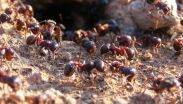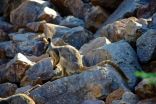INFORMATION:
Chitin of insects and crustaceans found to be active against pathogenic microorganisms
The results were obtained by KFU research group from the Department of Microbiology, in cooperation with Kazan Research Institute of Epidemiology and Microbiology and the Bioengineering Center of the Russian Academy of Sciences
2015-08-11
(Press-News.org) The study specifically concentrated on chitosan extracted from chitin in the carapaces of insects and crustaceans. The biopolymer was first discovered in 1859 but only recently has it become possible to establish its production within desired parameters, when researchers from the Bioengineering Center of RAS designed narrow-dispersion chitosan. This gave an opportunity to modern scientists to customize the biological properties of certain types of the biopolymer.
"We found that some forms of chitosan are toxic. They can disrupt the membranes of pathogenic microorganisms" explained Associate Professor of the Department of Microbiology Pavel Zelenikhin. "It is currently known that chitosan is effective against Klebsiella, Staphylococcus and Pseudomonas. Some forms of chitosan were also discovered to have antifungal properties".
The list of diseases caused by the aforementioned pathogens is very long. Klebsiella can cause pneumonia, urogenital infections, conjunctivitis, meningitis, septicemia, and intestinal infections. The same is true for Pseudomonas. Staphylococci (specifically Staphylococcus aureus) are well-known as the causes of many inflammatory infections.
To identify the effectiveness of chitosan on pathogenic microorganisms, the biopolymer was added to a suspension containing bacteria, followed by incubation (ranging between 30 - 120 mins) and supply of a colorant, which selectively marked dead cells; it was then possible to count the death toll cytometrically.
Following in-depth studies on biochemical capabilities of the biopolymer, the authors uncovered that chitosan destroys up to 90% of pathogens in selected cell cultures. It is especially valuable because no toxic effects on healthy cells have been observed.
ELSE PRESS RELEASES FROM THIS DATE:
Researchers develop fast test for invasive carp
2015-08-11
A Case Western Reserve University graduate student turned a research paper into a field test that quickly determines whether an Asian carp invading Lake Erie is sterile or can reproduce.
If proven successful, the technique could save money and time in the effort to keep the carp out of the Great Lakes, where the fish could grow unchecked and devour food supplies and habitat critical to native species..
Grass carp, the species Ctenopharyngodon idella, have been introduced throughout the Midwest and South to clear ponds choked with weeds. Also called the white amur, fertile ...
NYU study examines top high school students' stress and coping mechanisms
2015-08-11
Over time selective high schools have oriented themselves to address a context of increasingly competitive college admissions
School work, college applications, extracurricular activities, and parental expectations all contribute to teenagers' stress
Youth, schools, and experts identified substance use as a common strategy for coping with stress
"School, homework, extracurricular activities, sleep, repeat--that's what it can be for some of these students," says Noelle Leonard, PhD, a senior research scientist at the New York University College of Nursing (NYUCN). ...
Research pours cold water on ice bath recovery theory
2015-08-11
If the thought of a post workout ice bath is enough to make you shiver, new research from QUT and The University of Queensland (UQ) will warm your heart.
The comprehensive study found cold water immersion after strength training hindered muscle adaptation - pouring cold water on the long-held theory that an ice bath helps speed up recovery.
Dr Llion Roberts, from UQ's School of Human Movement and Nutrition Sciences, and Dr Jonathan Peake, from QUT's School of Biomedical Sciences, led the research, with colleagues from the Queensland Academy of Sport, Norwegian School ...
Common class of 'channel blocking' drugs may find a role in cancer therapy
2015-08-11
Drugs called ion channel blockers, which are commonly used to treat cardiac, neurological, and psychiatric disorders, might prove useful in cancer therapy, according to research findings in fruit flies and mice by UC San Francisco scientists that led to unconventional treatment of a case of metastatic brain cancer.
Ion channels, proteins that form pores in cell membranes, play central roles in organs in which conduction of electrical signals is vital, such as the brain and heart, but they are found in cells throughout the body. Although about 20 percent of FDA-approved ...
Bringing the Tasmanian devil back to mainland Australia would restore ecosystem health
2015-08-11
Sydney, Australia -- Reintroducing Tasmanian devils to the mainland could improve biodiversity by limiting the spread of red foxes and feral cats in habitats where dingoes have been culled, a new study suggests.
Tasmanian devils (Sarcophilus harrisii) once lived across the Australian continent, but went extinct on the mainland about 3,000 years ago - likely as a consequence of being hunted by dingoes.
Today, extensive dingo culls to protect livestock have shifted the ecological balance, paving the way for invasive predators to wreak havoc with native mammals, worsening ...
Statistical model helps police identify crime series; speeds apprehension of perpetrators
2015-08-11
SEATTLE, WA, AUGUST 11, 2015 - A statistical model--now an easy-to-use software tool--local police can use to identify a series of related crimes and nab a suspect was unveiled today by Michael D. Porter during a presentation at the 2015 Joint Statistical Meetings (JSM 2015) in Seattle.
Porter presented a talk titled "A Statistical Approach to Crime Linkage during a session focused on improving analysis of defense systems using statistical methods. He collaborated on the project with Brian J. Reich, associate professor of statistics at North Carolina State University.
Crime ...
Loss of altruism (and a body plan) without a loss of genes
2015-08-11
An international team of researchers found that the evolutionary loss of the "altruistic" worker caste in ants is not accompanied by a loss of genes.
Social insects, such as ants, are typically characterized by two distinct female castes: workers and queens. Previous research has found that workers and queens each express different sets of genes leading scientists to speculate that there are worker specific or "altruistic" genes that promote sociality.
Testing this "novel gene" hypothesis is difficult given that all ants are social. However, not all ants make workers. ...
Controlling feral animals & plants will save unique species & $billions
2015-08-11
Controlling feral pigs is the most cost-effective strategy to help save 148 endangered plant and animal species in the Lake Eyre Basin, and is just one of the significant findings of a three-year study led by QUT applied ecologist Associate Professor Jennifer Firn.
Professor Firn, from QUT's Institute for Future Environments, worked with Dr Josie Carwardine and CSIRO's Conservation Decisions team and a research team from the University of Queensland including Dr Ramona Maggini, to identify and prioritise 23 strategies to protect endemic species in the world's largest ...
Polyglutamine repeats play key role in functional development of cells
2015-08-11
Until now only known for role in polyglutamine diseases, such as Huntington's.
Scientists at VIB and KU Leuven have revealed that variable polyglutamine repeats in the DNA tune the function of the protein in which they reside. To date, these repeats were known only to cause severe neurodegenerative diseases such as Huntington's. These findings now show that polyglutamine repeats may be more than just harmful elements. The study was published in the leading molecular biology journal Molecular Cell and opens the door to further studies exploring new therapies for human ...
Mass extinction survival is more than just a numbers game
2015-08-11
Widespread species are at just as high risk of being wiped out as rare ones after global mass extinction events, says new research by UK scientists.
There have been five mass extinction events in the Earth's history, including climate change caused by volcanoes and an asteroid hit that wiped out the dinosaurs.
In general, geographically widespread animals are less likely to become extinct than animals with smaller geographic ranges, offering insurance against regional environmental catastrophes.
However, a study published in Nature Communications has found this insurance ...
LAST 30 PRESS RELEASES:
How do birds flock? Researchers do the math to reveal previously unknown aerodynamic phenomenon
Experts call for global genetic warning system to combat the next pandemic and antimicrobial resistance
Genetic variations may predispose people to Parkinson’s disease following long-term pesticide exposure, study finds
Deer are expanding north, and that’s not good for caribou
Puzzling link between depression and cardiovascular disease explained at last: they partly develop from the same gene module
Synthetic droplets cause a stir in the primordial soup
Future parents more likely to get RSV vaccine when pregnant if aware that RSV can be a serious illness in infants
Microbiota enterotoxigenic Bacteroides fragilis-secreted BFT-1 promotes breast cancer cell stemness and chemoresistance through its functional receptor NOD1
The Lundquist Institute receives $2.6 million grant from U.S. Army Medical Research Acquisition Activity to develop wearable biosensors
Understanding the cellular mechanisms of obesity-induced inflammation and metabolic dysfunction
Study highlights increased risk of second cancers among breast cancer survivors
International DNA Day launch for Hong Kong’s Moonshot for Biology
New scientific resources map food components to improve human and environmental health
Mass General Brigham research identifies pitfalls and opportunities for generative artificial intelligence in patient messaging systems
Opioids during pregnancy not linked to substantially increased risk of psychiatric disorders in children
Universities and schools urged to ban alcohol industry-backed health advice
From Uber ratings to credit scores: What’s lost in a society that counts and sorts everything?
Political ‘color’ affects pollution control spending in the US
Managing meandering waterways in a changing world
Expert sounds alarm as mosquito-borne diseases becoming a global phenomenon in a warmer more populated world
Climate change is multiplying the threat caused by antimicrobial resistance
UK/German study - COVID-19 vaccine effectiveness and fewer common side-effects most important factors in whether adults choose to get vaccinated
New ultraviolet light air disinfection technology could help protect against healthcare infections and even the next pandemic
Major genetic meta-analysis reveals how antibiotic resistance in babies varies according to mode of birth, prematurity, and where they live
Q&A: How TikTok’s ‘black box’ algorithm and design shape user behavior
American Academy of Arts and Sciences elects three NYU faculty as 2024 fellows
A closed-loop drug-delivery system could improve chemotherapy
MIT scientists tune the entanglement structure in an array of qubits
Geologists discover rocks with the oldest evidence yet of Earth’s magnetic field
It’s easier now to treat opioid addiction with medication -- but use has changed little
[Press-News.org] Chitin of insects and crustaceans found to be active against pathogenic microorganismsThe results were obtained by KFU research group from the Department of Microbiology, in cooperation with Kazan Research Institute of Epidemiology and Microbiology and the Bioengineering Center of the Russian Academy of Sciences

